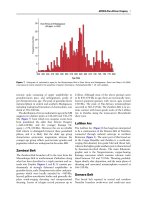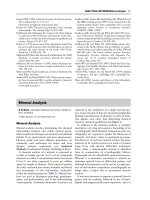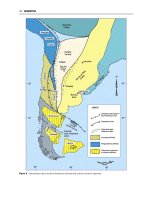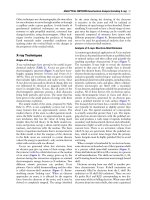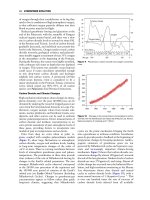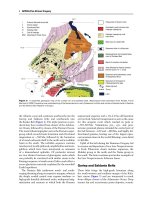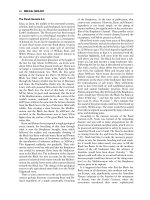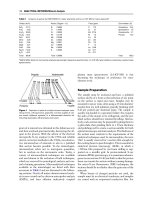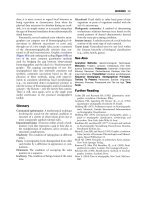Encyclopedia of geology, five volume set, volume 1 5 (encyclopedia of geology series) ( PDFDrive ) 1681
Bạn đang xem bản rút gọn của tài liệu. Xem và tải ngay bản đầy đủ của tài liệu tại đây (48.26 KB, 1 trang )
MINERALS/Definition and Classification 499
a case, the two end-members are regarded as species,
with a compositional range extending from the
end-member composition to the midpoint of the
solid-solution series, namely 50 mol%. ‘Olivine’ is
therefore regarded as a series or group name. Other
solid-solution series are more complex, as in the case
of ternary or higher order solid solutions, as exemplified by the mutual replacement of F, OH, and Cl in the
apatite series, giving rise to the end-member species
fluorapatite, hydroxylapatite, and chlorapatite, respectively. Further complications may involve
coupled substitutions, such as in britholite-(Ce), in
which the replacement of Ca2ỵ in the apatite structure
by Ce3ỵ is balanced by the substitution of P5ỵ by Si4ỵ.
In all such cases, the species is defined on the basis of
the predominant ion in a specified structural site.
Some minerals with identical compositions have
different crystal structures; examples include quartz,
tridymite, and cristobalite, all of which have the chemical formula SiO2 but which crystallize in the hexagonal, orthorhombic, and tetragonal crystal systems,
respectively. Such substances are called polymorphs
and qualify as separate mineral species because they
have different structures. On the other hand, there are
minerals with the same crystal structure but with different compositions, such as galena (PbS), periclase
(MgO), and halite (NaCl). These, too, are regarded as
separate species.
A structural variant that is sometimes encountered, notably in micaceous minerals, is created by the
rotation of one structural unit with respect to its structurally equivalent unit. When this perturbation is distributed throughout the structure as a regular stacking
sequence, the structural variant is called a polytype.
Polytypes are not regarded as separate species and are
indicated by the addition of a hyphenated suffix to
the root mineral name. The suffix takes the form of
a numeric symbol that represents the periodicity
with respect to the basic structural element, an alphabetic symbol that represents the crystal system, and
sometimes a numeric subscript that represents the
type of stacking. Some examples of mica polytypes
are muscovite-1M (monoclinic, with a periodicity of
1), muscovite-2M2 (monoclinic, with a periodicity of 2
and a particular stacking sequence), muscovite-3T (trigonal, with a periodicity of 3), and muscovite-2A
(anorthic, i.e., triclinic, with a periodicity of 2).
Although the crystal structure of a mineral is one
of the important properties defining a mineral species,
some mineral substances do not have a long-range
structural arrangement of the atoms comprising the
mineral. Minerals lacking this long-range order are
termed amorphous (if they were created in this form)
or metamict (if they originally possessed long-range
structural ordering, but the structural order was later
destroyed, usually as a result of ionizing radiation). An
amorphous mineral may be accepted as a valid species
if there is evidence that it is chemically homogeneous
and if spectroscopic characterization shows that it is
unique. A metamict mineral may be accepted as a valid
species if it can be established with reasonable certainty
that the original substance was a crystalline mineral,
generally by returning it to its original crystalline state
by heat treatment.
Many minerals were formed under conditions of
high temperature or pressure (or both) and are metastable under ambient conditions; others may tend to
hydrate or dehydrate when removed from their place
of origin. Such minerals may require special procedures to prevent their decomposition before an investigation is complete. The use of special procedures in
the investigation does not preclude the acceptance of a
metastable or unstable substance as a mineral, if it can
be adequately characterized and if it meets the other
criteria for a mineral.
The Validation of Mineral Species
Minerals have been given names since before the dawn
of history, and some of these names have survived as
valid species names to the present day. However, the
vast majority have not. Following the establishment
of the Commission on New Minerals and Mineral
Names (CNMMN) of the International Mineralogical
Association (IMA) in 1959, the introduction of new
mineral names has been strictly controlled, and publication of new mineral names and descriptions requires
prior approval by the national representatives of the
CNMMN. Proposals for the creation and naming of
a new species require a complete description of the
mineral, including chemical composition; crystallographic, physical, and optical properties; crystal structure (if possible); and specification of the type locality
where the mineral was discovered. If approved, the
specimen providing this information becomes the type
specimen for the species and is the specimen to which
all subsequent descriptions of the mineral from other
localities must be compared.
Minerals in the literature prior to the formation
of the CNMMN have been progressively winnowed
down to a generally accepted list of valid mineral
species by the mineralogical community in general,
and by activities of the CNMMN in particular. Subcommittees have been established by the CNMMN for
the review of mineral groups, including the amphibole,
mica, platinum-group alloys, pyrochlore, pyroxene,
and zeolite groups, and reports of these subcommittees
have been published in the open literature. Discreditation or redefinition of individual species has also been
done under the auspices of the CNMMN.
